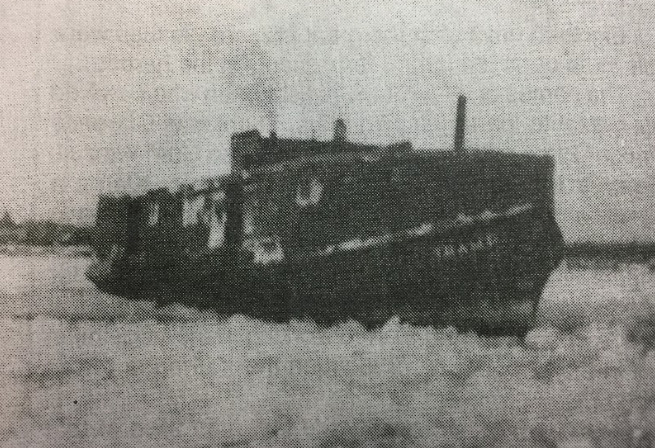The Tramp is joined by other boats as they experience success and distress while fishing Lake Huron.
It is a frigid, motionless February morning on Lake Huron. The thick layer of ice blanketing Lake Huron creaks and crunches as the newly built Tramp slowly trudges its way through. This boat is special—it can fish year-round, switching from gill nets to hooks in the winter. Alfred Nordstrand captains the 62-foot beast, which is powered by a top-notch, shiny steel Kahlenberg diesel engine that could reliably power the vessel to any desired prime fishing spot.
The Tramp hosts a five-man crew that works tirelessly day and night to transport fish from Providence Bay to Rogers City, where more workers shovel the fish into rusty, rugged refrigerator cars en route to nearby cities. This system was so efficient that fish could be put on the market in just nine hours after the initial catch. In the spring, the Tramp rushes to set nets in the lake as soon as possible, as they could reap the highest price for fish during Lent.
The Tramp's crew would become so remarkably exhausted that they once ran straight into a freighter. The crew was jolted awake, but the crash yielded minimal damage besides a pierced hull. The crew of the freighter graciously donated a load of iron ore to place in the stern, which would lift the nose out of the water. A mattress was then stuffed into the bow to slow down the leak, and both vessels swiftly continued on their way.
In its peak, the Tramp was extremely successful. At one point, the fishing business expanded so much that another boat became necessary, so the Katherine V was built to join the fleet of fellow vessels. This fleet consisted of multiple gill net tugs, such as the Rambler, Bobby Bill, Globe, and others. These were all part of the overarching Great Lakes fleet, consisting of hundreds of other vessels.
On one frosty morning in 1931, the Tramp left the harbor in search of a good catch. The Cartigan also came along to assist in smashing a path through the thick ice. However, ice cut their search short, and both ships became stuck in 20 feet of ice! Word was sent out, and the Katherine V, with few volunteers, hastily joined to help. The diligent crew worked tirelessly to free the vessel, but it still took seven days to break free. The Katherine V and Tramp resumed their plans to catch fish, but the duo eventually had to return. Rather than risk becoming stuck again, the crews mutually agreed to wait until the ice would part. The two vessels waited for two weeks until they could return. The boats reached nearly ¾ of a mile from shore, but the ice ahead of them was impenetrable. Both vessels left a watchman on duty at night in case the wind decided to change course.
The Tramp fished a long and successful life, coursing through the feast and famine of the fluctuating health of Lake Huron’s fishery. However, most of its partnering vessels were put out of commission, following the ban of gill nets in 1972. During its career, the Tramp continuously trudged, both literally and figuratively, through thick and thin.
Story written by Matthew Guest, Alpena HIgh School- Science in the Sanctuary, 2019
Prothero, Frank & Nancy. The Lone Survivor: The Katherine V of Rogers City. Nan-Sea Publications, 1990.
Cross, Clarence "Tuffy" & Bonnie. History Of Commercial Fishing On Thunder Bay 1835 To 2014 From Black River To Rockport. Sarge Publications, 2014.
